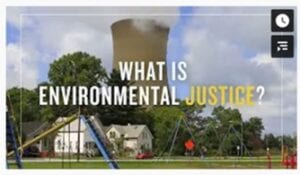According to the United Nations Commission on sustainable development, Sustainability is meeting the needs of the present without compromising the ability of future generations to meet their own needs. Sustainability has three main dimensions: social, economic, and environmental. Sustainable development in these three areas is necessary to ensure that human societies will endure, thrive, and last without destroying their environments and depleting their natural resources. [1]
For African American communities, the effects of racism on social and economic sustainability will often hamper their ability to respond to various threats to their environmental sustainability. [2]
When well-intentioned green development projects do not consider the economic and social factors at play in a particular neighborhood, this risks the creation of unintended outcomes such as green gentrification. [3]
If communities are not empowered to participate in the planning process through education and advocacy, the cycle of renewal, disenfranchisement, relocation, and urban blight will continue. [4]
It Does Not Have to Be This Way.
The growing use of green building practices in subsidized housing reflects the appeal of sustainability both in reductions in resource use and using less toxic materials such as: eliminating water waste in homes, applying constant maintenance of plumbing systems, i.e., leaky faucets, running toilets; conserving energy using energy-efficient light bulbs or turn off the light, not in use, and keeping thermostats at a constant reading, growing own food, and recycling represents examples of reductions in resources used, as well as the adoption of less toxic materials that can afford tenants better health, well-being, and clean air, in the absence of toxins.
These green building practices solve economically, environmental, and health problems, leading to the scaled-down cost of maintaining affordable housing.
The most significant and rewarding standpoint of Green Affordable Housing comes from the Health aspect. It provides a combination of healthy and sustainable features for low-income residents. Research shows that Green Housing can support health via traditional routes, such as affordability, stability, and quality through green design. Reducing absence from school and work, fewer doctor visits, overall fewer symptoms-related illnesses from substandard housing. Tenants must engage, be heard, and supported to obtain the cost, and the savings, to maximize the environmental advantages for their community.
There are three ways to prioritize tenants’ needs when incorporating the green design. 1. Tenants benefit from green elements that require little to no learning curve. 2. Tenant engagement is essential in more complex green solutions. 3. Green affordable housing can be healthy affordable housing. [5]

Affordable, sustainable, green housing can bridge the gap and connect housing, health, and racial equality
The Green Affordable Housing movement emerges from a desire to combat economic disparities, sustainability, and human health. Introducing green housing to the low-income segment of society; narrows the equation of promoting better health, savings to income by reducing utility costs for income-restricted households; the segment, of society needing it the most with very few lifestyle changes. Research by New Ecology indicates green building features used in affordable housing can cost less than conventional affordable housing costs. Thereby, building affordable green housing lends to erasing the stigma that green housing is a luxury afforded only by the affluent. [6]


